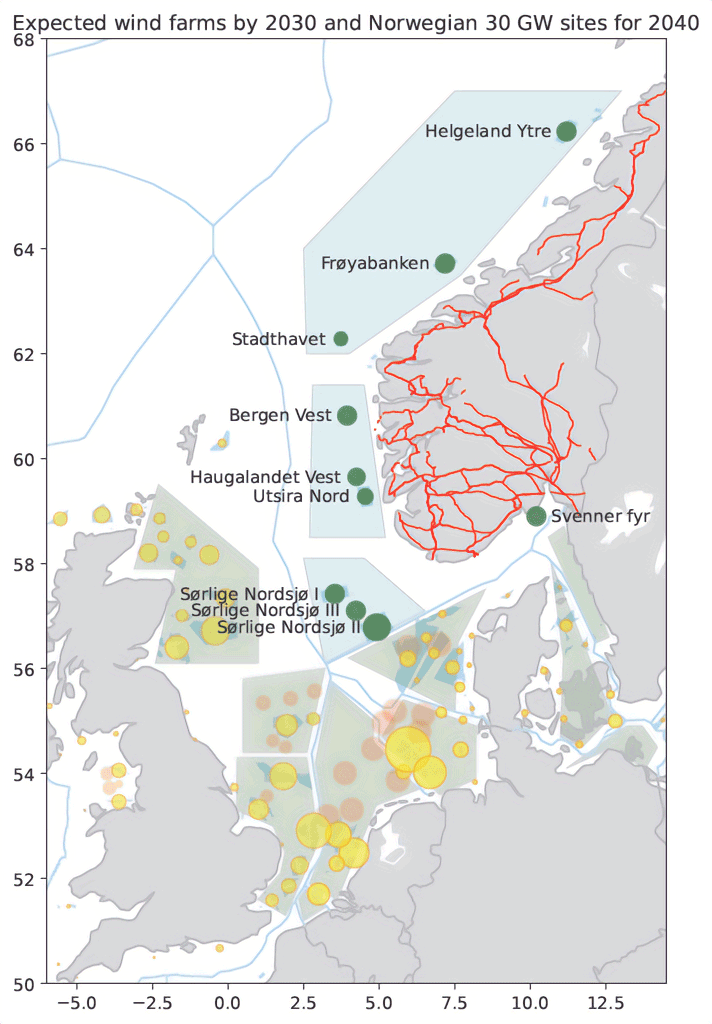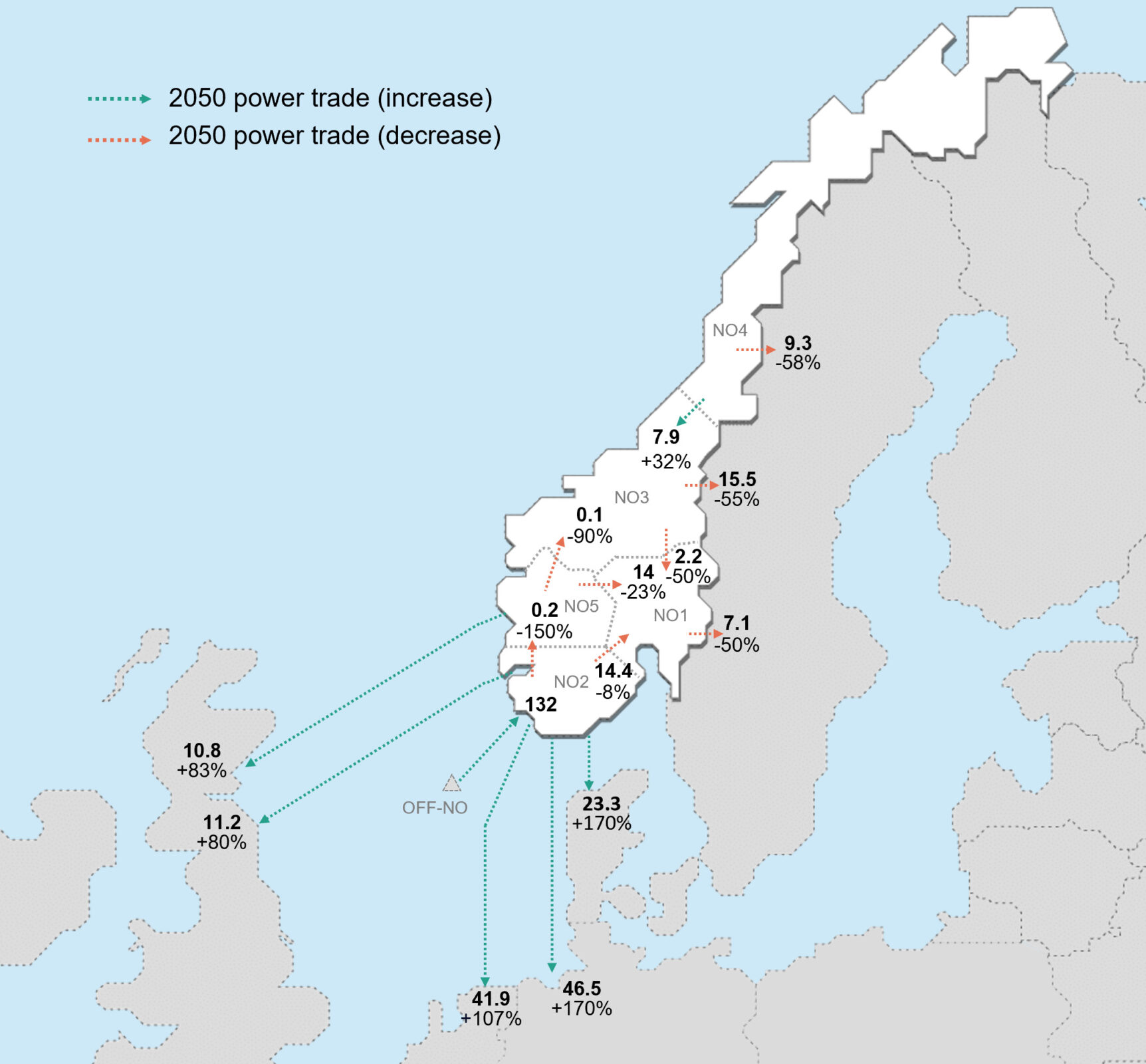About half of Norway’s overall energy consumption is fossil based. Decarbonising this half of the energy consumption and simultaneously facilitating sustainable growth in Norway are key challenges going forward.
The energy landscape in Europe is undergoing an unprecedented transition. Achieving a sustainable zero-emission society requires profound changes to the energy system. This affects Norway as well as our neighbouring countries. Even though Norway has a substantial renewable share with regards to our electricity production, due to factors such as very good conditions for hydropower, about half of the country’s overall energy consumption is fossil based. Decarbonising this half of the energy consumption and simultaneously facilitating sustainable growth in Norway are key challenges going forward.
Increased electric energy consumption needs increased power production
Given the projected increase in the electric energy consumption, there needs to be an increase in power production in order to avoid a negative power balance. This increase can come from onshore or offshore sources. The North Sea has the potential to produce vast amounts of wind energy. By investigating the overall energy system in Norway and other countries surrounding the North Sea, the effects of exploiting this potential can be mapped and quantified.
The scale of the current ambitions for 30 GW of offshore wind licences awarded in Norway by 2040 is on par with the current production capacity of the entire Norwegian hydropower. The introduction of such large amounts of intermittent power needs to be considered in a holistic manner in order to avoid conflicts and sub-optimal solutions.
For example, there are several factors to consider regarding the placement of the production facilities, such as climatic considerations, effects on the local environment and biodiversity, land usage issues, generation potential considerations, and cost considerations. The generated power also needs to be transported to the consumption points in an efficient manner, and the same considerations apply.
The potential layout of offshore wind farms for the North Sea is changing rapidly, and how this system will look in the future is uncertain. Energy system modelling can help identify desired strategies, and clarify and quantify the consequences of choices regarding power production type, locations, balancing technologies, and other relevant aspects.

Modelling the effects of introducing offshore wind energy to the grid
As part of the Ocean Grid Research project, we used the energy system model GENeSYS-MOD to study the effects of introducing varying amounts of energy from offshore wind energy to the grid.
GENeSYS-MOD is a capacity expansion model that minimises the overall system costs in terms of both investment costs and operation costs. It enables us to simulate energy production and transportation capacities in order to meet set end-user energy demands. The model optimises combinations of production technologies, energy transportation technologies, and storage technologies in order to reach a cost optimal system.
The model starts at an initial year (in our case, 2018) and invests in capacity in the optimal technologies in five-year increments towards 2050. This enables us to track the development of the energy system over this timeframe. Various assumptions regarding the investment and operational costs for different technologies need to be made. Sensitivity studies may also be performed to check the sensitivity of the results toward variations in the assumptions. We can also identify tipping points in technology costs, which can impact the uptake and deployment of certain technologies.
Furthermore, the model uses weather data to consider realistic renewable energy production from sources such as wind and solar. There are considerable variations in some of these parameters from year to year, and again this can be studied to check the robustness of the optimisation towards these variations.
Overall energy scenarios were taken from the openEntrance project. The total end-user energy consumption for the various bidding zones in Norway can be seen in the image below. While the overall end-user energy consumption goes down, the degree of electrification goes up. This results in an overall increase in electricity consumption in Norway. This simultaneous fall in overall energy consumption combined with an increase in electric energy consumption is mostly due to the higher degree of efficiency in the electrified energy usage, higher carbon penalties and assumptions that energy use will decline due to more awareness and action from regulations and policies, society, and technological advancements.

Preliminary results
Recently, the preliminary results from this project were presented at the European Energy Market conference 2023 in Lappeenranta, Finland. In this work, we compared having offshore wind energy production located in each zone in Norway (disaggregated case) to having all offshore production in one node connected to southern Norway (NO2) with a forced capacity expansion in this offshore zone (aggregated case). This is a preliminary study that will be further developed with a more realistic offshore wind distribution and further disaggregation of surrounding areas. However, the results still provide an insight into the effects of introducing such large amounts of offshore wind energy into the Norwegian energy system.
Read more: Large-scale Offshore Wind Development and Decarbonization Pathways of the Norwegian Energy System
The introduction of large amounts of offshore wind capacities will affect the installed capacities in the rest of Norway. The dashed lines in the six graphs below indicate the disaggregated case, where offshore production is spread over the five zones of Norway and there is no forced offshore capacity expansion. The full-line part of the plot indicates the capacity expansion for the aggregated case, with forced offshore wind installations connected to NO2.
The results shows that the installation of photovoltaic (PV) capacity is greatly reduced, and the installation of onshore wind power is also significantly reduced. For both the disaggregated and aggregated caeses, what little fossil power generation that remained in the system is phased out rapidly. Hydropower is still a major part of the power mix, but the limited expansion potential given in the model limits its growth. The image also shows in which zone of Norway the effects will be most prominent.

It is important to note that these results stem from a cost-minimisation model, and that the capacity expansions outlined represent the most economically favourable options. The realisation of these scenarios will require all the factors mentioned in the introduction to be considered, as well as licensing procedures based on political processes.
The GENeSYS-MOD model also enables us to study trade routes and in particular, transmission grid expansions. The introduction of all offshore wind production into price area NO2 naturally results in a substantial increase in power exports from this zone. In the modelling results, the majority of the export from the zone is also exported from Norway and imported to Germany. This is done both through direct export to Germany, and indirect export through Denmark and the Netherlands. Export is also increased to the UK. In this case the North Connect lines are still included.

Further simulations to be conducted
As noted above, these results are preliminary, and the simulations will be enhanced further in the project. A more realistic distribution of the offshore wind power locations will be established, a revision of the transmission grid limitations will be conducted, and sensitivity studies will be performed with regard to the cost assumptions for the various technologies. Furthermore, stochasticity in terms of hydropower generation and other weather-related energy production technologies will be investigated.










Comments
No comments yet. Be the first to comment!